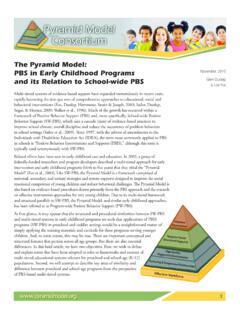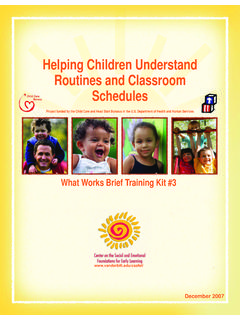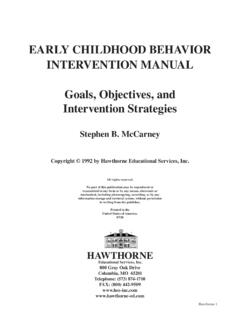Transcription of MANAGING CHALLENGING BEHAVIORS IN EARLY …
1 1 MANAGING CHALLENGING BEHAVIORS IN EARLY childhood : EFFECT OF THEORETICAL ORIENTATION ON STRATEGY RECOMMENDATION By ERIN MICHELLE ANDERSON A DISSERTATION PRESENTED TO THE GRADUATE SCHOOL OF THE UNIVERSITY OF FLORIDA IN PARTIAL FULFILLMENT OF THE REQUIREMENTS FOR THE DEGREE OF DOCTOR OF PHILOSOPHY UNIVERSITY OF FLORIDA 2007 2 2007 Erin Michelle Anderson 3 To my loving and supportive family 4 ACKNOWLEDGMENTS My sincerest gratitude goes out to all of those who have supported me throughout the duration of this project. I express my never-ending appreciation to family, specifically, my mother and step-father, Shirley and Curt Gilmer, my father, Rodney Anderson, and my brother and step-sister, Christopher Anderson and Kelli Gilmer, for their continued encouragement, guidance and love.
2 I owe my accomplishments to them. I thank my friends who have continuously supported my passions and academic endeavors, and have supported me immensely over the past seven years. I thank Mary Thomas and Christina Hayes (my friend and part-time statistical consultant) in particular for always believing in me. Finally, I express my gratitude to the professionals who have supported me throughout this project. My dissertation committee, Drs. Nancy Waldron, Hazel Jones, and Kristen Kemple, as well as those who have served on my committee in the past, Drs. Jennifer Asmus, Maureen Conroy, Randy Penfield, and Anne Seraphine. They have shared their individual and combined knowledge and expertise over the years, which have facilitated the completion of this project. I also thank Dr. David Miller and Dr. Stephen Hooper for the generous assistance with my statistical analyses.
3 Most importantly, I thank my dissertation committee chair and advisor, Dr. Tina Smith-Bonahue, for her constant wisdom, encouragement, and guidance. She has continuously supported and challenged me throughout my academic career, and for that I am eternally grateful. 5 TABLE OF CONTENTS page ACKNOWLEDGMENTS ..4 LIST OF TABLES ..8 CHAPTER 1 LITERATURE REVIEW ..10 CHALLENGING BEHAVIORS in EARLY childhood ..10 Increased Use of Definition of CHALLENGING Defining CHALLENGING BEHAVIORS in relation to their environmental Types of CHALLENGING Severity of CHALLENGING BEHAVIORS ..16 Developmental Nature of CHALLENGING The Transactional Nature of CHALLENGING BEHAVIORS ..18 The Impact of CHALLENGING CHALLENGING BEHAVIORS across the life span ..21 Effects of CHALLENGING BEHAVIORS on social relationships.
4 23 Effects CHALLENGING BEHAVIORS on academic performance ..24 Empirically Supported Strategies for Addressing CHALLENGING The Role of Theoretical Constructivist Perspectives for MANAGING CHALLENGING BEHAVIORS ..29 Perspectives regarding management strategies ..29 Programmatic interventions ..30 Specific constructivist strategies ..36 Behavioral Perspectives for MANAGING CHALLENGING BEHAVIORS ..37 Strategies aimed at enhancing communication Specific behavioral Comparisons Between Constructivism and Behaviorism ..44 Importance of Quality Childcare ..45 Practitioners Need for Perceived competence and CHALLENGING BEHAVIORS ..51 Perceived competence and 2 METHODS ..57 Participants ..57 Instrumentation ..57 The Behavioral Challenges in EARLY childhood Education: Professional s Demographic Questionnaire.
5 60 Procedure ..60 Data 6 Scoring and Statistical Analyses ..61 Research Hypothesis ..62 Data analyses ..62 Reliability ..63 3 RESULTS ..65 Descriptive Statistics ..65 Demographic Variables ..66 Age ..67 Years of experience ..67 Area of Degree held ..68 Race/ethnicity ..68 Gender ..69 Split-Plot Analysis of Variance (SPANOVA) ..69 Follow-up Analysis of Open-Ended 4 Relationship Between Strategy and Theoretical Orientation ..86 Relationship Between Strategy Recommendation and Types of CHALLENGING behavior ..87 Physical aggression ..87 Verbal aggression ..88 Noncompliant behavior ..88 Trends in Open-Ended Implications of the Findings ..92 Limitations of the Current Study ..95 Internal External Validity ..98 Future Research ..99 APPENDIX A DEMOGRAPHIC QUESTIONAIRRE ..103 B BEHAVIORAL CHALLENGES IN EARLY childhood EDUCATION.
6 104 C BEHAVIORAL CHALLENGES INE ARLY childhood EDUATION: PROFESSIONAL'S SURVEY DEMOGRAPHIC D BEHAVIORAL CHALLENGES INE ARLY childhood EDUATION: PROFESSIONAL'S SURVEY ..111 E CONTACT 7 LIST OF REFERENCES ..118 BIOGRAPHICAL SKETCH ..130 8 LIST OF TABLES Table page Explanation of assignments of numerical values and statistical analyses used for demographic and survey 4-2 Analysis of variance for age ..75 4-3 Analysis of variance for years of experience ..76 4-4 Analysis of variance for area of specialization ..77 4-5 Analysis of variance for degree held ..78 4-6 Analysis of variance for race/ethnicity ..79 4-7 Descriptive statistics for race/ethnicity ..80 4-8 T-tests for gender ..81 4-9 Mauchley s test of sphericity ..81 4-10 SPANOVA using the Huynh-Feldt correction.
7 82 4-11 Marginal means for theoretical orientation by strategy ..82 4-12 Marginal means for strategy by behavior ..83 4-13 Percentage (%) and number (n) of open-ended categories by theoretical orientation ..84 4-14 Sample of open-ended strategies reported by 4-15 Open-ended strategies reported by constructivists ..85 9 Abstract of Dissertation Presented to the Graduate School of the University of Florida in Partial Fulfillment of the Requirements for the Degree of Doctor of Philosophy MANAGING CHALLENGING BEHAVIORS IN EARLY childhood : EFFECT OF THEORETICAL ORIENTATION ON STRATEGY RECOMMENDATION By Erin Michelle Anderson December 2007 Chair: Tina Smith-Bonahue Major: School Psychology CHALLENGING BEHAVIORS in young children are a growing problem that interferes with children s social-emotional and academic development.
8 Within the field of EARLY childhood , experts differ regarding appropriate practices for addressing CHALLENGING behavior in young children. This study explores the relationship between experts theoretical orientations and strategy recommendations for addressing 3 types of CHALLENGING BEHAVIORS in young children. This study examines whether identifying as a behaviorist or constructivist affects specific strategies recommended for MANAGING physical aggression, verbal aggression, and noncompliance in three- and four-year-old children. Participants responded to survey vignettes regarding the likelihood that they would recommend 11 strategies. Theoretical orientation and the behavior presented were found to impact the likelihood of specific strategy recommendation. Implications regarding the impact of such findings on consultative relationships and teacher training is discussed.
9 10 CHAPTER 1 LITERATURE REVIEW CHALLENGING BEHAVIORS in EARLY childhood behavior problems have long been a common and troubling problem for educators, with detrimental side effects both for students and teachers. In fact, CHALLENGING BEHAVIORS are cited as one of the greatest challenges faced by preschool teachers and childcare providers each year (Arnold, McWilliams, & Arnold, 1998). As EARLY as 1980, researchers suggested that as many as 24% of all preschool children demonstrated significant CHALLENGING BEHAVIORS (Earls, 1980). In 1993, Webster-Stratton found that the incidence of difficult BEHAVIORS was steadily increasing. Although citing a slightly lower prevalence rate, Campbell (1995) suggested that between 10-15% of preschool children exhibit mild to moderate behavior problems. Willoughby, Kupersmidt, and Bryant (2001) report startling numbers of preschool children exhibiting antisocial BEHAVIORS -- approximately 40% of preschoolers exhibit at least one, and approximately 10% of preschools exhibit six or more antisocial BEHAVIORS a day.
10 More currently, Fixsen, Powell, and Dunlap, (2003) suggested that between 8 and 25% of all preschool and kindergarten children display externalizing BEHAVIORS in the classroom. These rates suggest that CHALLENGING BEHAVIORS have been present in preschool and childcare settings for a number of years and remain a significant problem today. The numerous consequences of such difficult BEHAVIORS result in a myriad of problems for children and teachers. For example, Bryant and colleagues (1999) suggest that coping with disruptive, aggressive, and noncompliant BEHAVIORS in the classroom environment is one of the biggest concerns for childcare providers and Head Start teachers (Bryant, Vizzard, Willoughby, & Kupersmidt, 1999). The concern of MANAGING CHALLENGING BEHAVIORS is becoming increasingly important to understand as the use of childcare environments is steadily increasing (Buck & 11 Ambrosino, 2004).



















